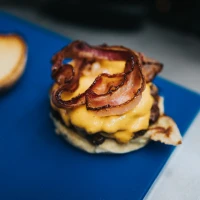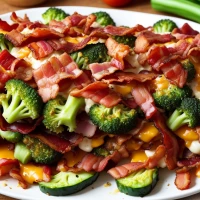Bacon is a beloved ingredient in many kitchens around the world for its smoky flavor and crisp texture. Understanding how to bake bacon perfectly at 375°F transforms it into a culinary masterpiece that enhances any dish. For those aiming at healthy eating, focusing on vegetable-based dishes doesn’t mean you have to forego the delight of perfectly baked bacon as an occasional treat or garnish. This ultimate guide will navigate you through the intricacies of baking bacon flawlessly, ensuring it complements your vegetable-centric meals with just the right crunch every single time.
Perfectly Baked Bacon: A Journey to Crispy Excellence
Baking bacon might seem straightforward, but achieving that perfect level of crispness without overcooking can be a challenge. When done correctly, the result is irresistibly flavorful bacon that’s both tender and crisp. The optimal temperature for this balance is often said to be 375°F—a sweet spot that cooks the bacon uniformly, allowing the fat to render slowly without burning the meat.
The Benefits of Baking Bacon at 375°F
- Even Cooking: Unlike frying, baking at 375°F ensures each strip of bacon cooks evenly without the need for constant attention and flipping.
- Reduced Splatter: Forget about grease splatters on your stovetop. Baking bacon contains the grease within the baking sheet for an easy cleanup.
- Better Texture: The moderate yet consistent heat allows bacon to crisp up without becoming too hard or chewy.
- Versatility: Whether accompanying a vegetable quiche or topping a hearty salad, baked bacon at 375°F can be the perfect sidekick for various dishes.
Preparing Your Baking Setup
To begin, you’ll need a few key items:
- A rimmed baking sheet: the rim keeps the bacon grease from spilling into the oven.
- Parchment paper or aluminum foil: for lining the baking sheet to further ease cleanup.
- A wire rack (optional): elevating the bacon allows for air circulation and even crispier results.
The Baking Process: A Step-by-Step Guide
- Preheat your oven to 375°F.
- Line your baking sheet with parchment paper or foil for easier cleanup.
- Arrange the bacon strips in a single layer on the baking sheet or on a wire rack set over the sheet.
- Place the bacon in the preheated oven and bake until it reaches your desired level of crispiness, typically between 15 to 25 minutes depending on thickness.
- Remove and drain on paper towels to absorb any excess grease.
Tips for Achieving the Perfect Crispiness
- Thicker cuts of bacon will require more time in the oven.
- Rotate the baking sheet halfway through cooking for uniform crispiness.
- Keep a close eye on the bacon in the last few minutes as it can go from perfect to overdone quickly.
Elevate Your Vegetables with Baked Bacon
Bacon’s rich flavor profile can elevate the taste of any vegetable dish. Whether it’s roasted brussels sprouts or a fresh garden salad, adding a sprinkle of crispy bacon can make your vegetable dish a showstopper.
Pairing Bacon with Vegetables: A Match Made in Heaven
- Brussels Sprouts: Roasted with olive oil and finished with crumbled bacon pieces.
- Sweet Potatoes: Cubed, roasted, and garnished with bacon for a sweet and savory combination.
- Asparagus: Wrapped in bacon and baked until tender.
Creating Harmony Between Flavors and Textures
When incorporating bacon into your vegetables, focus on balance. The saltiness of the bacon pairs well with the natural sweetness of many vegetables, while the crispy texture provides a delightful contrast to softer veggies.
Healthy Bacon Alternatives for Vegetable Dishes
For those opting for a healthier version, turkey bacon or vegetarian bacon made from plant-based ingredients can be baked using the same method, ensuring that you don’t have to compromise on flavor or texture in your quest to incorporate more vegetables into your diet.
The Science Behind Baking Bacon at 375°F
When you bake bacon at 375°F, you’re utilizing a cooking method that’s both an art and a science. The heat reacts with the bacon in a way that renders the fat slowly, which is key to achieving that coveted crispy yet tender texture.
Understanding the Rendering Process
- Fat Rendering: A slow and gentle process at this temperature allows the fat to melt away without burning the meat.
- Maillard Reaction: The golden brown color and complex flavors of baked bacon are a result of this reaction between amino acids and reducing sugars.
The Role of Oven Temperature Control
Maintaining a stable oven temperature is crucial for consistent results. Too high, and the bacon will burn; too low, and it won’t crisp up. A calibrated oven ensures your bacon is baked to perfection.
Creative Ways to Use Baked Bacon in Vegetable Dishes
Utilize your perfectly baked bacon by incorporating it into a variety of vegetable dishes, taking them from ordinary to extraordinary.
Inspiring Ideas for Every Meal
- Breakfast: A vegetable omelette adorned with crispy bacon bits.
- Lunch: A refreshing spinach and avocado salad sprinkled with bacon.
- Dinner: A savory veggie burger topped with a slice of baked bacon for an added crunch.
Vegetarian-Friendly Bacon Options
- Using vegetarian alternatives like coconut bacon or shiitake mushroom bacon can provide a similar texture and smoky flavor to your dishes without the meat.
Seasonings and Marinades: Enhancing Baked Bacon
While bacon boasts its own robust flavor, adding seasonings or a marinade before baking can take your bacon to new heights of deliciousness.
Ideas for Seasonings and Marinades
- Sweet: Brown sugar or maple syrup creates a caramelized glaze.
- Savory: A dash of smoked paprika or garlic powder for added depth.
- Spicy: A sprinkle of cayenne pepper for those who like it hot.
Tips for Seasoning Bacon
- Apply seasonings and marinades before baking for maximum flavor absorption.
- Make sure to coat the bacon evenly for a consistent taste experience.
Final Thoughts on Baking Bacon at 375°F
Baking bacon at 375°F is more than just a cooking method—it’s a gateway to enhancing your meals, especially vegetable-based dishes, with rich flavor and satisfying texture. By following the guidelines in this ultimate guide, you’ll be well on your way to achieving crispy bacon perfection that’ll impress at any dining occasion.
Remember, the keys to perfectly baked bacon are even heat, timing, and attention to detail. Whether you prefer pork, turkey, or vegetarian alternatives, mastering the art of baking bacon at 375°F will give you the confidence to elevate the simplest of vegetables to gourmet status. Enjoy your culinary adventure and the irresistible delights that come with each crispy slice.










